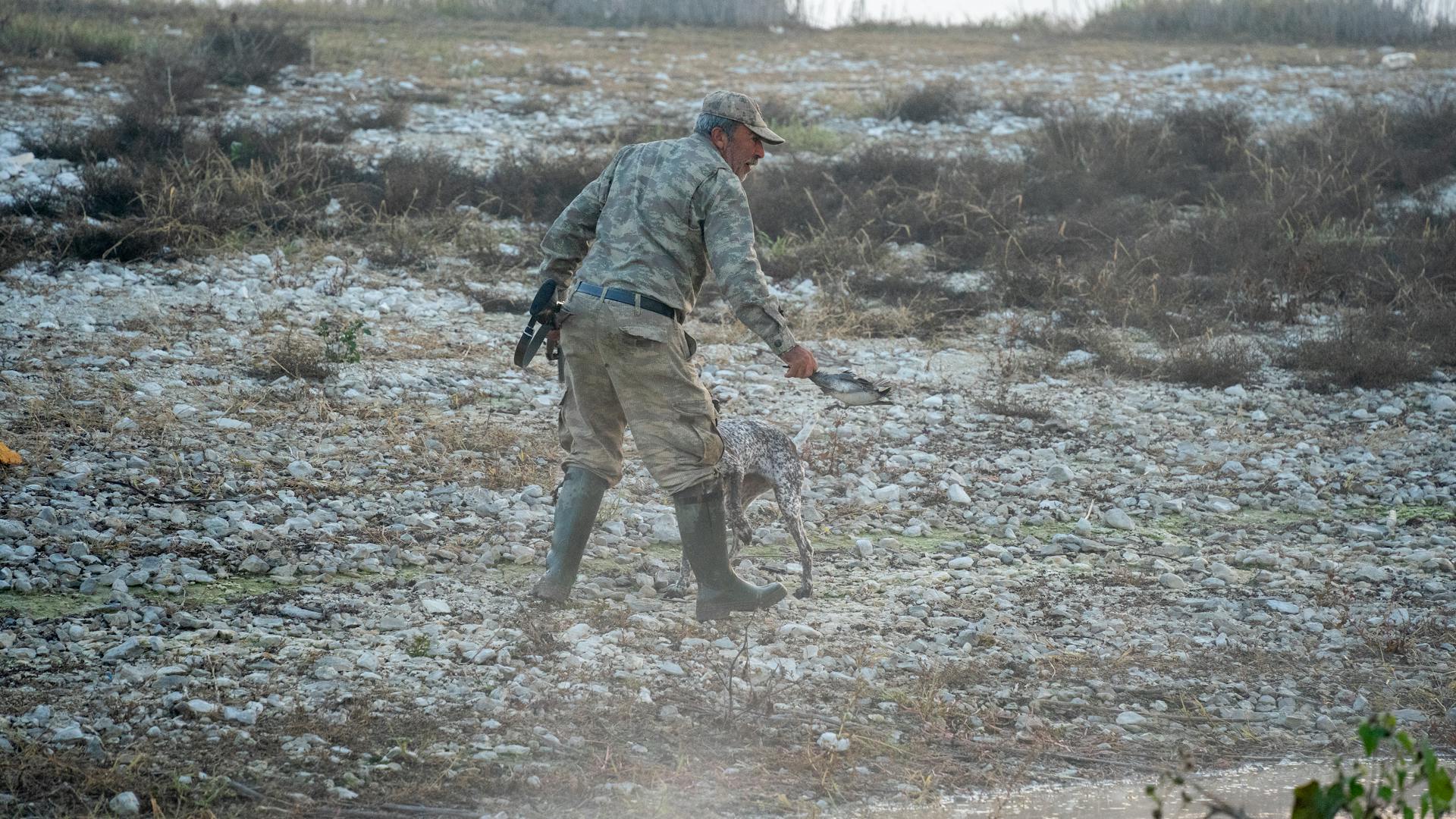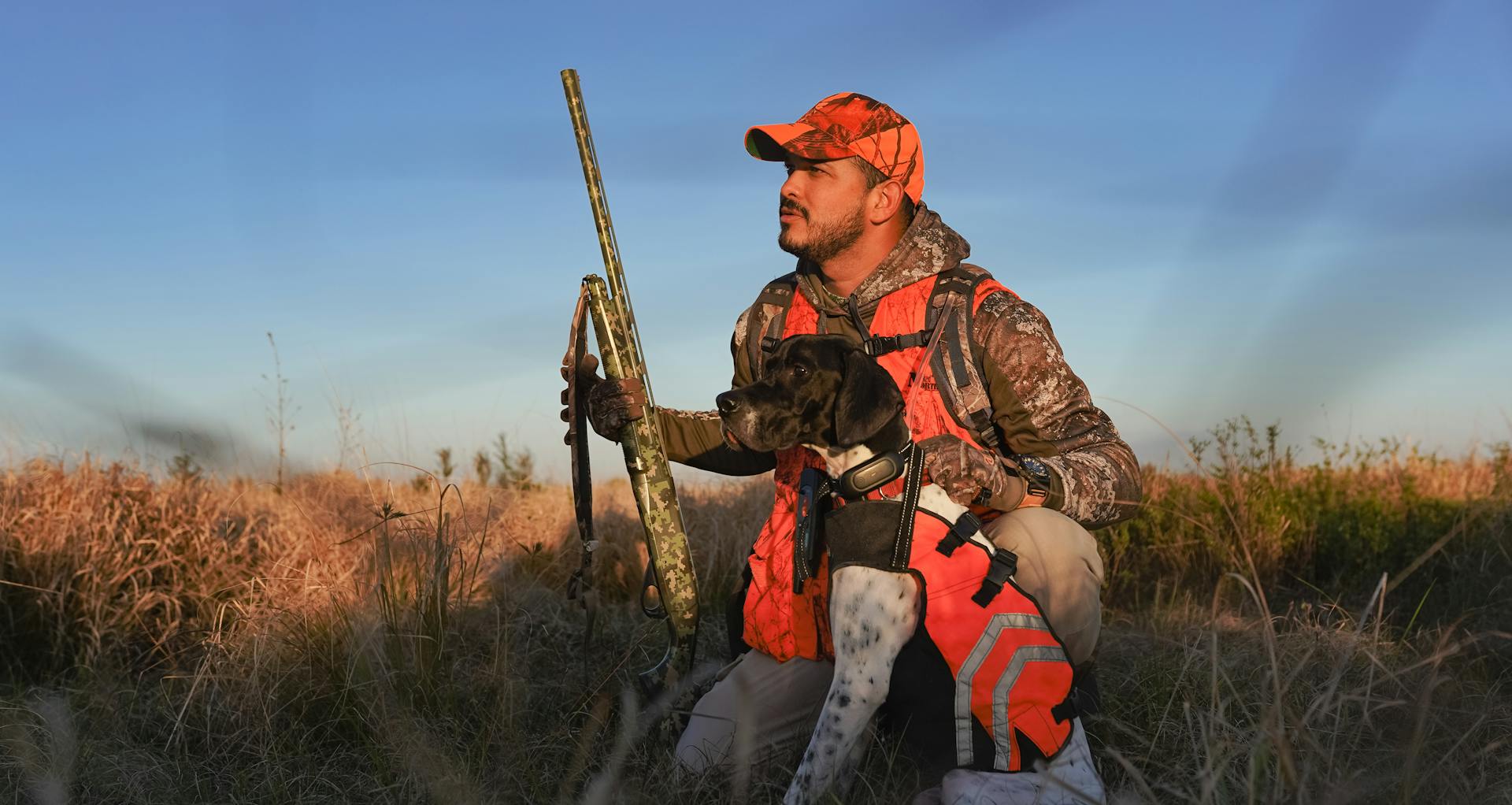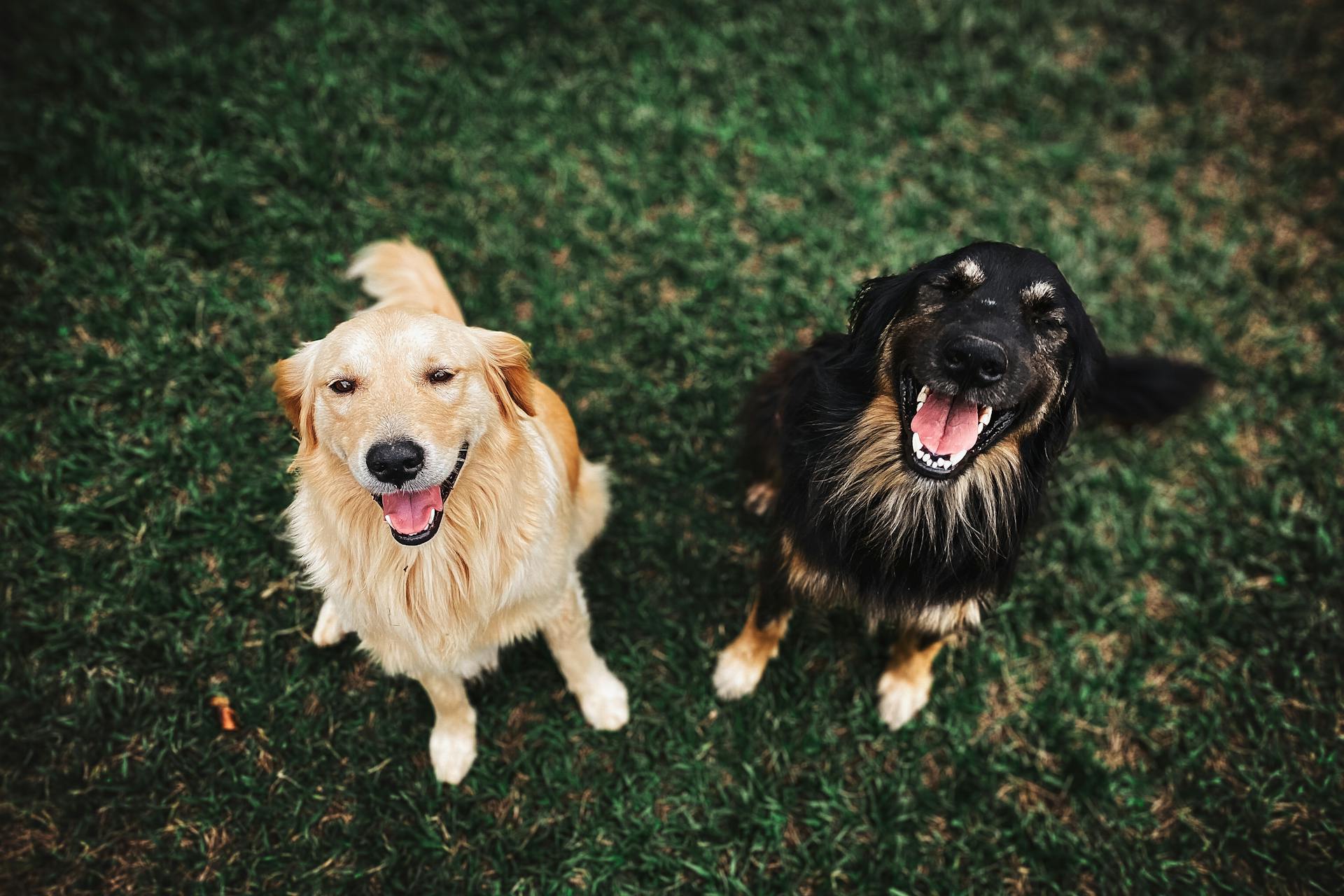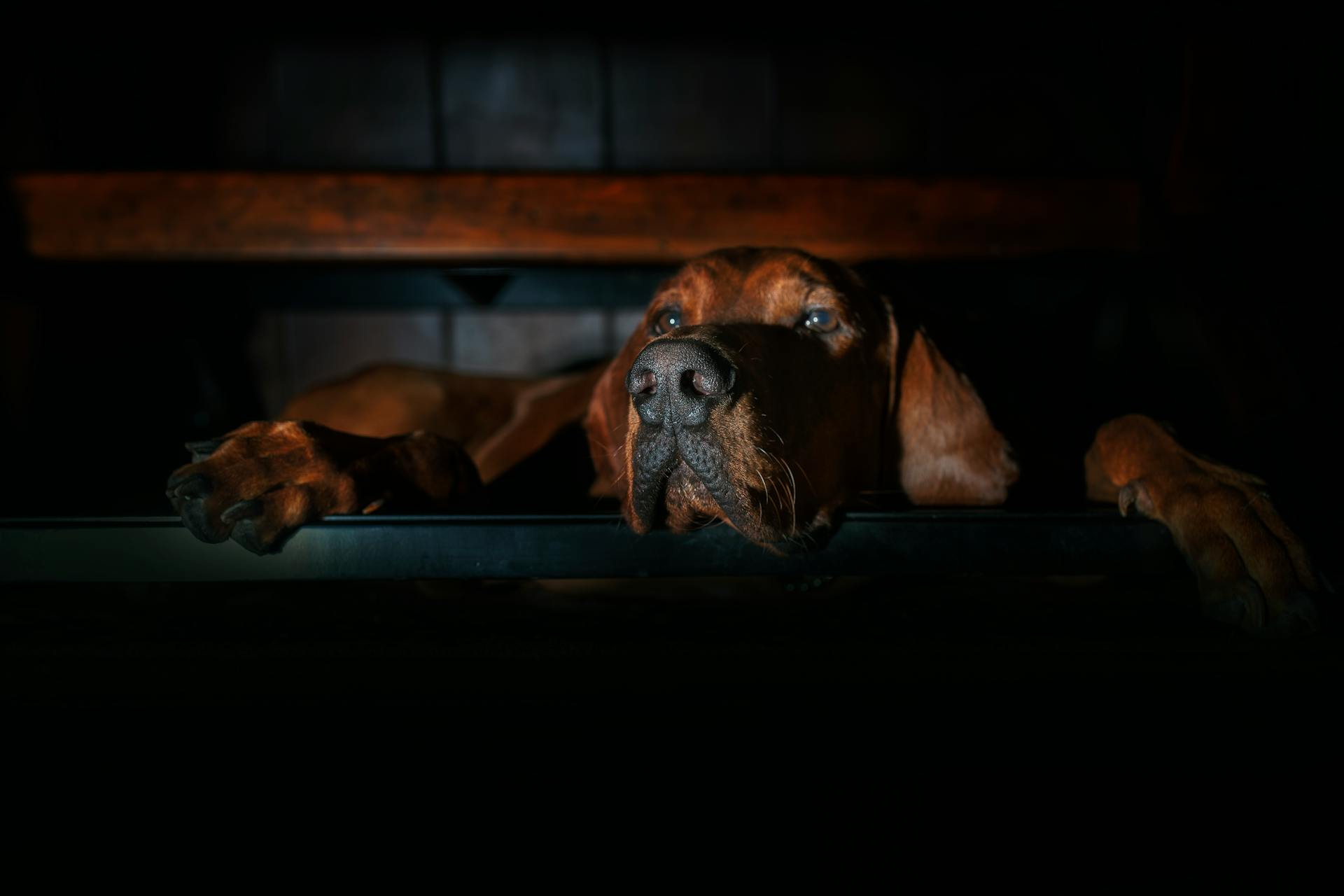
The Redbone Coonhound is a versatile and energetic breed that excels in hunting and family life. They have a short, smooth coat that requires minimal grooming.
Originating from the southern United States, this breed is known for its distinctive red coat and athletic build. Their history dates back to the 18th century when they were bred for hunting small and large game.
Redbone Coonhounds are natural athletes, built for endurance and agility. They require regular exercise to stay happy and healthy, making them a great fit for active families or hunters.
Their friendly and outgoing personalities make them an excellent choice for families with children or for those who want a loyal companion.
You might enjoy: Long Coat Chesapeake Bay Retriever
Quick Facts
The Redbone Coonhound is a medium to large breed, weighing between 45-70 pounds.
This breed has a short, smooth, and dense red coat that requires some maintenance.
Originating in the United States, the Redbone Coonhound is part of the Hound breed group.
These dogs have a lifespan of 12-15 years, making them a long-term companion.
The Redbone Coonhound is an affectionate, gentle, and outgoing breed that makes a great family pet.
They require high exercise needs, so be prepared for regular physical activity.
Early and consistent training is recommended for this breed to ensure good behavior.
Some potential health concerns for the Redbone Coonhound include hip dysplasia, elbow dysplasia, and cherry eye.
Breed Overview
The Redbone Coonhound is a medium-size breed, typically standing between 21-27 inches tall. They come in a variety of red colors, including solid red and red & white.
Redbone Coonhounds have a lifespan of 12-15 years, making them a long-term companion for many families. They're also relatively lightweight, weighing in at 40-70 pounds.
Here are some key physical characteristics of the Redbone Coonhound breed:
- Height: 21–27 inches
- Weight: 40–70 lbs
- Lifespan: 12–15 years
- Breed Size: Medium
- Colors: Red, red & white
Breed Group
If you're curious about your dog's breed group, you can check out Wisdom Panel's DNA tests, which can help you discover your dog's ancestry.
Redbone Coonhounds, for example, are part of the Hound breed group, which is known for their tracking abilities.
Breed groups can give you an idea of your dog's original purpose and characteristics.
The Hound breed group, in particular, is comprised of breeds that were bred for hunting and tracking.
Wisdom Panel's DNA tests can help you learn more about your dog's breed group and ancestry.
Understanding your dog's breed group can also help you tailor their care and training to their specific needs.
Check this out: Boston Terrier Group
Overview
The Redbone Coonhound is a medium-sized breed, standing between 21-27 inches tall, and weighing between 40-70 pounds. They have a lifespan of 12-15 years.
Their distinctive feature is their solid red coat, which can sometimes come with a white patch. They're known for their sweet, devoted, and affectionate nature, making them great companions.
Redbone Coonhounds are friendly and loyal, but they can be prone to barking at home, so it's essential to have a suitable living situation or very understanding neighbors. They require plenty of exercise to stay happy and healthy.
Here are some key characteristics of the Redbone Coonhound breed:
- Height: 21–27 inches
- Weight: 40–70 lbs
- Lifespan: 12–15 years
- Breed Size: Medium
- Colors: Red, red & white
- Good With: (Some) kids, other dogs, cats
- Temperament: Sweet, devoted, affectionate
Physical Characteristics
The Redbone Coonhound is a stunning breed with a sleek and muscular build. They typically stand between 21 and 27 inches tall at the shoulder, with males being slightly taller than females.
Their coat is one of their most distinctive features, with a rich, deep red color that's often described as looking like mahogany. The coat is short and smooth, but coarse enough to provide protection to the skin.
Redbone Coonhounds have long, floppy ears that are set fairly low on their head. Their eyes are round and expressive, coming in shades of brown from hazel to dark brown.
One of the breed's most recognizable features is their nose - it's black and prominent, with a distinctive "masking" of black on the muzzle and around the eyes. Their large paws are compact and well-padded, similar to a cat's.
The breed standard allows for a small amount of white on the chest and feet, but the coat should always be a solid red color. Males typically weigh between 45 and 70 pounds, with females being slightly lighter.
Here's a summary of the breed's key physical characteristics:
Hound Temperament & Personality
The Redbone Coonhound is a friendly and outgoing breed that thrives on social interactions. They love being part of family activities and can get along well with other dogs, especially those with high energy levels like Border Collies.
Their loyal and affectionate nature makes them devoted companions, but they can be independent and stubborn at times, requiring positive reinforcement training. They're intelligent and quick learners, but their independent streak can make training a challenge.
Redbone Coonhounds are not aggressive, but their enthusiasm can sometimes be misinterpreted as aggression. With proper training, socialization, and exercise, they can become polite members of society.
They have a powerful nose and can get distracted by scents, which can lead to impulsive behavior. Starting training early and providing plenty of exercise can help curb these instincts.
Redbone Coonhounds are energetic and athletic, requiring regular daily exercise to keep them happy and healthy. They love engaging in activities like hiking and swimming, but they also enjoy lounging on the couch with their family.
You might like: Are Pit Bulls Good Family Dogs
Their strong prey drive can lead them to chase smaller animals, so early socialization and training are essential to ensure peaceful cohabitation with other pets. With the right introductions and training, Redbone Coonhounds can make wonderful additions to households with children and other animals.
They're generally patient and gentle with children, making them a great breed for families with kids. However, it's essential to supervise interactions between dogs and young children to prevent accidental rough play.
Redbone Coonhounds are not biters, but they may "play bite" harder than you'd like. Teaching them not to bite while they're puppies is crucial to prevent any unwanted behavior.
Overall, Redbone Coonhounds are loving and loyal companions that thrive on interaction and activity. With the right training and care, they can become wonderful additions to any family.
Suggestion: Black Mouth Cur Bite Force
Care and Feeding
Redbone Coonhounds require daily exercise, such as walks, runs, or play sessions, to maintain their physical health and expend their high energy levels.
Their distinctive red coat needs regular brushing to remove loose hair and maintain its sheen, with occasional shedding in the spring and fall.
To ensure good behavior, socialization and training are vital, especially with other dogs and animals, as Redbone Coonhounds are intelligent but can be independent.
They thrive on social interaction and companionship, so it's essential to spend quality time with them and not leave them alone for long periods.
A balanced diet that meets their nutritional needs, based on age, activity level, and overall health, is crucial, and high-quality dog food is a good choice.
Fresh water should always be available, and consulting with a veterinarian for personalized dietary recommendations is recommended.
Redbone Coonhounds typically do well on a high-quality commercial dog food, but it's essential to factor in their age and choose a formula suitable for large-breed dogs.
Treats should be given in moderation to avoid obesity, which can lead to health problems like diabetes and joint conditions.
Readers also liked: Catahoula Leopard Dog Health Issues
Feeding

Feeding your Redbone Coonhound requires a balanced diet that meets their nutritional needs based on age, activity level, and overall health.
High-quality dog food, whether dry kibble or wet canned food, is a good choice as it offers complete and balanced nutrition.
It's essential to follow the feeding guidelines provided on the dog food packaging to ensure you're feeding your Redbone Coonhound the right amount.
You can expect to pay between $100 to $300 per year for your healthy, adult Redbone Coonhound's routine vet care, assuming no serious health conditions.
Treats can be handy rewards for training your Redbone, but be sure to give them in moderation to avoid packing on the pounds.
Obesity can lead to other health problems like diabetes and joint conditions, so keep a close eye on your pup's weight and adjust their diet accordingly.
Additional reading: Redbone Coonhound Health Issues
Routine Dog Care
To keep your Redbone Coonhound happy and healthy, regular exercise is a must. Daily walks, runs, or play sessions are essential to help them expend their high energy levels.
Their distinctive red coat requires minimal grooming, but regular brushing is necessary to remove loose hair and maintain its sheen. Be prepared for occasional shedding, especially in the spring and fall.
Socialization and training are vital for these dogs, as they can be independent and require consistent, positive reinforcement-based training methods. Early socialization with other dogs and animals is also important to promote good behavior.
A balanced diet is crucial for your Redbone Coonhound's overall health. High-quality dog food, whether dry kibble or wet canned food, is a good choice as it offers complete and balanced nutrition. It's essential to follow the feeding guidelines provided on the dog food packaging and adjust the portion size according to your dog's specific requirements.
Providing fresh water at all times is also essential for your dog's health. Regular veterinary check-ups are necessary to ensure your Redbone Coonhound stays healthy, with an average yearly price of $100 to $300 for a healthy, adult dog.
Discover more: Bluetick Coonhound Health Issues
Health and Grooming
Redbone Coonhounds are generally healthy dogs, but like all breeds, they can be prone to certain health issues. Their lifespan is 12 to 15 years, and they are prone to fewer health conditions than other dog breeds. Regular veterinary check-ups are essential to detect and manage potential health problems.
Hip dysplasia, ear infections, obesity, bloat, and heart issues are some of the health concerns that Redbone Coonhounds may experience. Hip dysplasia involves abnormal development of the hip joint, which can lead to arthritis and mobility problems. Ear infections can be caused by their long ears, which can trap dirt and moisture.
To maintain their health and prevent common health issues, regular exercise, a balanced diet, and proper grooming are crucial. They require weekly brushing with a shedding blade and a bristle brush to remove loose hair and distribute skin oils. Regular ear cleaning and inspection are also essential to prevent ear infections.
Here are some common health issues that Redbone Coonhounds may experience:
- Hip dysplasia
- Ear infections
- Obesity
- Bloat
- Heart issues
To keep their coat looking its best, Redbone Coonhounds require a weekly brush with a shedding tool or grooming mitt, and a bath every four to six weeks. Regular nail trims and ear checks are also necessary to maintain their overall health.
Health
Redbone Coonhounds are generally healthy dogs, but like all breeds, they can be prone to certain health issues. Regular ear cleaning and inspection are essential for Redbone Coonhounds due to their long ears that hang close to the ground, making them more susceptible to ear infections.
Hip dysplasia is a common orthopedic issue in many breeds, including Redbone Coonhounds, which involves abnormal development of the hip joint, leading to arthritis and mobility problems.
Obesity is a significant concern for Redbone Coonhounds, as they have hearty appetites and a love for food, which can lead to weight gain if not carefully managed. Monitoring their diet and providing regular exercise is crucial to maintain a healthy weight.
Suggestion: Weight Pulling Pit Bulls
Bloat is a life-threatening condition where the stomach fills with gas and can twist on itself, requiring immediate veterinary attention if suspected. Redbone Coonhounds are one of the breeds prone to gastric dilatation-volvulus (GDV), commonly known as bloat.
Here are some common health issues in Redbone Coonhounds:
- Hip Dysplasia
- Ear Infections
- Obesity
- Bloat
- Heart Issues
Some health issues are more prevalent in Redbone Coonhounds, including hip and elbow dysplasia, panosteitis, coonhound paralysis, and progressive retinal atrophy (PRA). Regular vet check-ups can help detect and manage these issues early on.
If you're a Redbone Coonhound owner, it's essential to be aware of these potential health problems and take preventative measures to ensure your furry friend lives a happy and healthy life.
Health and Grooming
The Redbone Coonhound's grooming needs are relatively low maintenance, but they still require some regular care to stay clean and healthy.
Their short, smooth coat is easy to brush, and a weekly brushing with a shedding tool or grooming mitt can help minimize shedding.
Redbone Coonhounds have a double coat and shed frequently, so regular brushing is essential to prevent matting and tangling.
You'll want to brush their ears as well, as their heavy ears can be prone to infection and nasty germs.
A weekly brush can also help redistribute oils on their back, which can transfer to other surfaces and leave stains.
Bathing your Redbone Coonhound every four to six weeks is a good rule of thumb, unless they're extremely active and need a bath more often.
Daily teeth brushing is a must, especially for Redbone Coonhounds, as poor dental hygiene can cause tooth loss and other medical problems.
Annual professional teeth cleanings by your vet are also necessary to keep their teeth clean and healthy.
Regular nail trims and ear checks are also important to keep your Redbone Coonhound in top shape.
By following these simple grooming tips, you can help keep your Redbone Coonhound happy, healthy, and looking their best.
Here's an interesting read: Black Mouth Cur Teeth
Preventative Medications
Preventative Medications are a crucial part of your Redbone Coonhound's health routine. It's essential to budget for these expenses, as they can add up quickly.
Typically, a year's worth of tick, heartworm, and parasite treatments can cost a couple hundred dollars. Your vet may also recommend additional vaccines based on your geographic region and your pup's lifestyle.
These additional vaccines can cost anywhere from $100 to $200.
For another approach, see: Bavarian Mountain Hound Cost
Training
Training your Redbone Coonhound requires patience and consistency. They're intelligent and eager to please, but can be easily distracted by interesting scents.
To get the most out of their intelligence, keep training sessions short, like 10 minutes at a time, and reward them with treats, praise, and playtimes with special toys when they do a good job.
Redbone Coonhounds are moderately intelligent and respond well to positive reinforcement. They're not suited for harsh training techniques, which can be counterproductive.
Basic obedience training is essential, teaching commands like sit, stay, and come, and how to walk nicely on a leash. Leash training is crucial, as these dogs are strong and can pull you along if they get excited about a squirrel.
A confident and calm leader is key to successful training. Redbone Coonhounds thrive on structure and clear communication, making them responsive to commands and praise.
With plenty of patience, rewards, and affection, you can help your Redbone Coonhound excel in dog sports like coonhound trials and agility courses.
Rescue Groups
If you're looking to bring a Redbone Coonhound into your life, there are dedicated rescue groups and organizations that can help. These groups are committed to providing a second chance to dogs of this breed in need of new homes.
You can find Redbone Coonhound rescue groups through online resources like the Coonhound Companions Rescue Network and the Rescue Shelter Database (Redbone Coonhound).
If you're unable to find a breed-specific rescue, you can expand your search to rescues dedicated to the welfare of Coonhounds and other types of Hounds.
Here are some notable rescues to consider:
- Coonhound Companions Rescue Network
- Rescue Shelter Database (Redbone Coonhound)
- AKC Coonhounds – Directory of Rescues in Every State
- Rescue Me! Redbone Coonhound Rescue
- Coonhound Rescue
- Coonhound Rescue Network Page
- Northeast Coonhound Rescue
- Petfinder
- Pet Adoptions by Overstock
General Information
The Redbone Coonhound is an all-American breed, developed by American settlers during the nation's expansion to the west and south.
They were bred to be agile, hot-nosed, fast, and excellent at treeing game, forcing small animal prey to run up a tree.
This breed is one of six hounds created by American settlers, and they were developed to provide a reliable source of raccoon meat and fur during the expansion.
The History of

The Redbone Coonhound originated in the late 18th century in the Southern United States, specifically in the regions of Tennessee and Georgia.
The breed was developed by selectively breeding Foxhounds and Bloodhounds, which were brought from Ireland and Scotland, to create a dog that was exceptional at hunting and treeing raccoons.
These early ancestors of the Redbone Coonhound were known as "Saddlebacks" due to their distinctive black saddle-like marking on their back, but this characteristic was eventually bred out to create the solid red coat we see today.
The breed was developed to be agile, hot-nosed, fast, and excellent at treeing game, making them a reliable source of raccoon meat and fur during the westward expansion of the United States.
The Redbone Coonhound was recognized by the United Kennel Club in 1902 and later by the American Kennel Club in 2009, solidifying its place as a distinct breed.
Here are some key dates in the history of the Redbone Coonhound:
- Late 1700s: Scottish immigrants introduce red foxhounds to America.
- 1840s: George F.L. Birdsong breeds Irish-bred Foxhound and Bloodhound lines in Georgia.
- 1902: The Redbone Coonhound is recognized by the United Kennel Club.
- 2009: The breed is recognized by the American Kennel Club.
Environment

Redbone Coonhounds love being around people and kids, but they need supervision when playing with small children because they can accidentally knock them down with their bouncy nature.
They thrive in homes with spacious yards, but can adapt to apartment living if they get enough daily exercise.
Their baying bark can be a challenge in apartment living, and their love of singing and howling might disturb neighbors at 2 AM.
Redbones need to be with their people for most of the day, as they don't like being left alone for long.
They love getting attention from guests, but their loud bark makes them effective watchdogs rather than guard dogs.
A securely fenced yard is essential to keep them safe and contained, as their hunting instincts can take over and lead them to follow scents and pursue prey.
A unique perspective: Bluetick Coonhound Bark
Frequently Asked Questions
What are the drawbacks of having a Redbone Coonhound?
Redbone Coonhounds may be prone to health issues like hip dysplasia and ear infections, and are also at risk of injuries while hunting due to their active nature
Is a Redbone Coonhound a good family dog?
Yes, Redbone Coonhounds make great family dogs due to their loving and loyal nature. They are a versatile breed that thrive in family environments.
Do redbone Coonhounds bark a lot?
Redbone Coonhounds are prone to barking, especially if they don't receive enough exercise and mental stimulation. This trait makes them a better fit for homes with yards where they can run and play freely.
What are 5 facts about redbone Coonhounds?
Here are 5 key facts about Redbone Coonhounds: They are friendly, trainable, and playful, with a strong desire for family attention. On average, they live 11-12 years and are generally a healthy breed.
Featured Images: pexels.com

